Su-33 / Su-27K

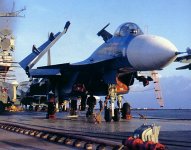
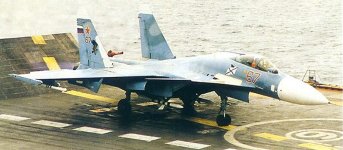
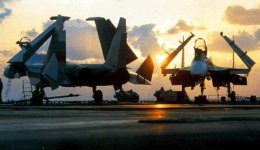
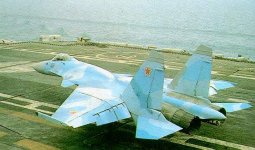
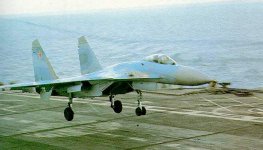
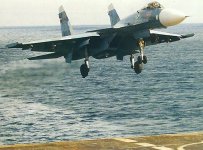
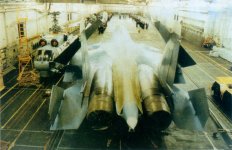
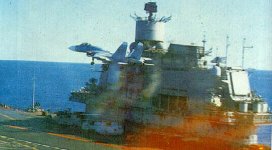

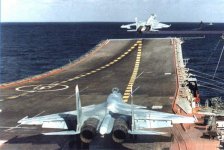
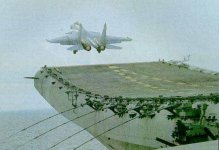
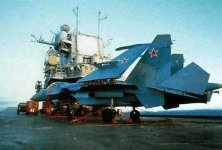
Su-30
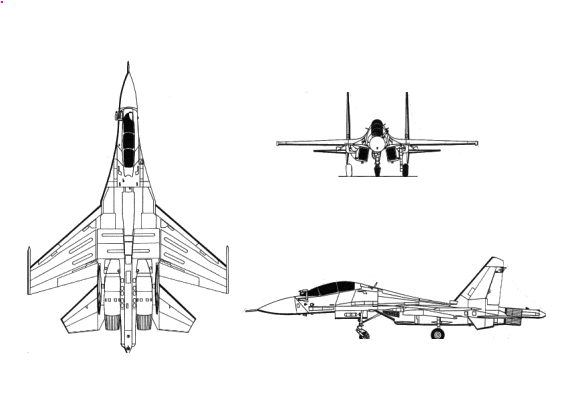
Su-32
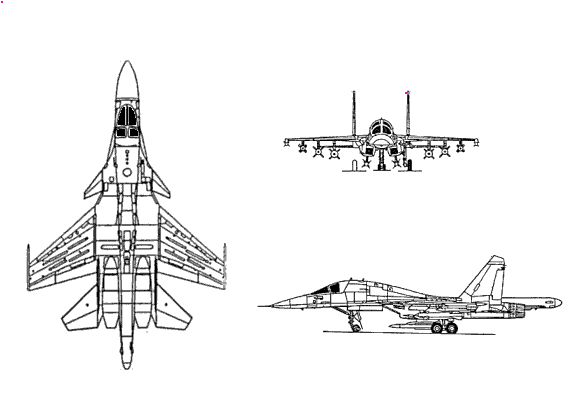
Su-34
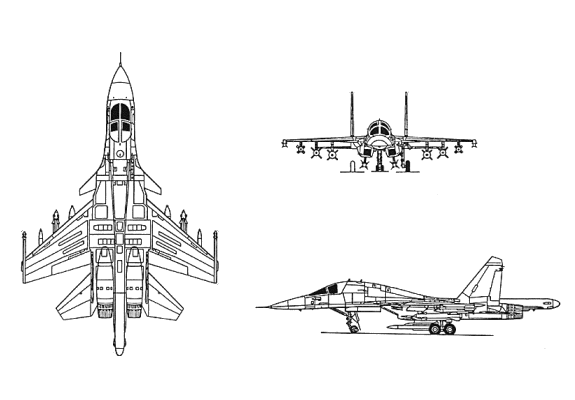
Su-35
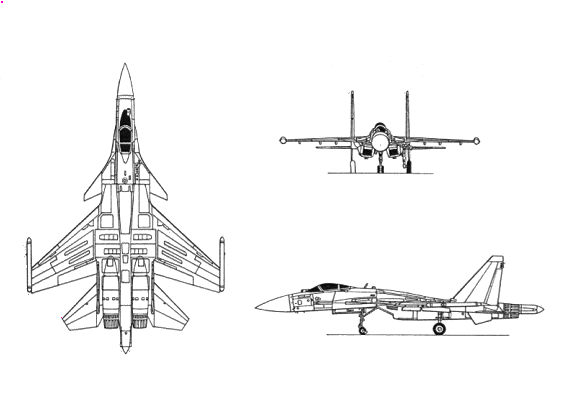




The Su-30s cost approximately $34 million each - considerably more than the F-16. India, for example, has agreed to buy 40 Su-30MK two-seat fighters for $1.2 billion. Indonesia's planned purchase of Russian fighters and helicopters has been postponed indefinitely owing to the country's economic crisis and the savage devaluation of the Rupiah. The Indonesia Department of Defence announced in 1997 that it would buy 12 Sukhoi Su-30K fighters in place of the F-16 Fighting Falcon fighters it originally planned to buy from the US. Indonesia already operates a squadron of 12 F-16s.Su-30 (Su-27P) is a two-seat long-range intercept fighter that first flew in December 1989, and that entered service with the Russian air forces in 1992. Largely based on the Su-27UB two-seat trainer, it has a new radiolocation system which can transmit the positions of 10 targets to four other fighters at the same time. The Su-30 is made in Irkutsk.
Su-30M (MK-export version) is a standard Su-30 with the air-to-ground missiles which can carry twice the armament (8 tons) compared to the baseline Su-27. The Su-30 'export variant' of the formidable Su-27 'Flanker', can carry the latest Russian air-to-air missiles, including the medium-range R-27 family, the short-range R-73 and the new medium-range R-77 'AMRAAM-ski'. The Sukhoi-30K has a range in excess of 3,000km, which means it can easily patrol offshore installations without requiring aerial refuelling. In June 1999 Russia agreed to sell 72 of these front-line Sukhoi-30 jet fighter-bombers to China. The aircraft building enterprise in Komsomolsk-on-Amur (KnAAPO) is likely to become the main supplier of a large lot of Su-30MKK fighter jets to China. The cost of one Su-30MKK fighter jet is estimated at $35 million - $37 million. At the same time, negotiations began for Moscow to grant a licence for the production of another 250 Sukhoi-30 fighters. The Su-30MKK for China is different in details from the Su-30MKI version designed for India. Sukhoi has a $1.5-$1.8 billion deal to supply 40 Su-30MK to India. In 1997, a total of eight aircraft were supplied under this contract, which should be completed at the end of 1999. Negotiations to license the production of the Su-30MKI to the Hindustan AeronauticsLimited (HAL) works of India continued in 1997. The Indians received feasibility plans, and it is thought that a final decision would be reached this year. Production in India would begin after 2001. In all, India might produce 100 warplanes in a contract worth more than $1 billion. However, as of mid-1999 negotiations on the contract for the licensed production of Su-30MKI fighter by HAL remained delayed due to the government crisis in India, which could not be resolved until after the Fall 1999 elections. The two sides had agreed on all the basic issues, including the value of the licensing contract. As of mid-2000 India had received only eight SU-30K air defence aircraft and none of the upgraded SU-30MK multi-role aircraft in the Rs 6310-crore deal signed with Russia in 1996. There had been no deliveries after May 1997. India's Defence Research Development Organisation had failed to develop and supply key avionics sub-systems and failed to procure Western avionics to equip the SU-30MK aircraft for its designated multi-role. Under the contract, the Irkutsk aircraft production association will deliver 40 Su-30s to the Indian air force. Within the framework of a contract worth $1.8bn Russia will deliver to India 40 military planes Su-30 in different versions. At the end of 1999 Irkutsk aviation industrial association 'Irkut' was finishing the assembly of ten Su-30MK multifunctional long-range for India's Air Forces, equipped with aerial refuelling capabilities. After the deliveries are complete, HAL plans to launch production of new modifications of Su-30s under a Russian license in cooperation with Sukhoi. The Sukhoi-30 can be modified into a naval version, if the Indian Government decides to acquire an aircraft carrier.
Su-32FN is the two-seat multi-role reconnaissance and strike export version of the Su-34 fighter-bomber.
Su-33 (Su-27K) is a carrier-based variant that first flew in May 1985, and entered service in the Russian Navy in 1994. The air regiment comprising 24 fighters of the type was formed up on Russia's only operating aircraft carrier, the Admiral Kuznetsov. It has extra small wings near the pilots cabin which shorten the take-off distance and improve manoeuvrability. The Su-33 can also carry guided missiles such as the H-25MP, H-31 and H-41. The Su-33 is used in both night and day operations at sea, and operate with the command center ship and with the Ka-31 early-warning helicopter. With the R-27EM missiles it can intercept antiship missiles.
Su-34 (Su-27IB - Istrebitel-Bombardirovshchik) is a two seat ("arm-to-arm") strike variant that first flew in 1990. It features frontal wings and a large flattened nose with sharp edges (like the SR-71) reduce radar cross-section. This new ship-borne fighter is fitted with two AL-31FP engines with vectored thrust. Using them allows either the take-off distance or maximum take-off weight (MTOW) of the aircraft to be increased by 10-15 per cent. The aircraft has a distinctive large "sting" in the rear which contains the NO-14 radiolocation system, a radioelectronic countermeasures system, and a fuel tank. The Su-32 and Su-34 have been developed and are in serial production in Novosibirsk for the Russian Ministry of Defence.
Su-35 (Su-27M) is a single-seat attack fighter that first flew in 1988. The Su-35 and Su-37 are made in Komomolsk-na-Amure. Like the Su-33 it features small wings near the cabin to enhance manoeuvrability. It also has new digital pilot control and digital engine control systems, replacing the analog computers in the original Su-27. The radar, with a range of 400 km, can follow the position of 15 targets and fire at 6 of them at the same time. An improved "Zuk" ("Scarab") radar features a mobile (+/- 130 degree) antenna which can follow position of 24 targets with ability to fire to 8 of them. The rear "sting" has a radiolocation system, which moved back the center of gravity, and which along with other innovations improve its tactical ability. Armaments includee: R-77, R-73, KS-172, R-27EM/AE, R-27E, R-27, H-31, H-29L/T, KAB-500L/KR, KAB-1500, H-15, H-65, H-59M, S-25LD, 500kg and 250 kg bombs.
Su-37 Super Flanker is a single-seat and/or two-seat multi-role combat aircraft that was first shown in model form at 1991 trade shows. Some wind tunnel tests completed as the aircraft entered the basic design stage in 1992, with foreign partners being sought for development. Unlike the other twin-engine Su-27 derivatives, the Su-37 concept originally featured a single Soyuz/Tumansky turbofan engine rated at 180 kN (40500 lb st) thrust with afterburning. What finally emerged from the design process was a supermanoeuvrable version of the Su-35 with a pair of AL-37FU afterburning turbofans with axisymmetric, steerable nozzles and thrust vector control (TVC). When the Su-37 was shown at Farnbrough in 1996 it stole the show, performing an astounding aerobatic display.
Specifications | ||||||
| Country of Origin | Russia | |||||
| Builder | Sukhoi | |||||
| Role | ||||||
| Similar Aircraft | ||||||
| Armament | Su-34
carried on twelve external points Su-37 | |||||
| Cost | approximately $35 million | |||||
| User Countries | ||||||
| Su-33 | Su-30M | Su-30MKI | Su-34 | Su-35 | Su-37 | |
| Crew | 2 | 2 | 2 | 2 | 1 | 1 |
| Dimensions, m Wing Span Length Height |
7.4 + 14.70 21.94 5.93 |
14.70 21.94 6.36 |
14.70 21.94 6.36 |
14.70 23.34 6.36 |
14.70 22.20 6.43 |
14.70 22.20 6.43 |
| Wing Area, m2 | 62 | 62.04 | 62.04 | 62 | 62 | 62 |
| Weights, kg empty Normal Maximum |
- - 30,000 |
- 24,000 33,500 |
17,700 25,670 34,000 |
- 39,000 45,000 |
18,400 25,700 34,000 |
18,500 25,670 34,000 |
| Payload, kg Maximum Normal |
6,500 1,400 |
8,000 1,400 |
8,000 1,400 |
8,000 1,400 |
8,000 1,400 |
8,000 1,400 |
| Fuel, kg Maximum Normal |
- - |
5,090 9,400 |
5,090 9,400 |
- 12,100 |
11,000 13,400 |
11,000 13,400 |
| Engine | 2 Lyulka AL-31 afterburning turbofans | 2 Lyulka AL-31 afterburning turbofans | 2 Lyulka AL-31 afterburning turbofans | 2 Lyulka AL-31MF afterburning turbofans, 27,557 lb thrust each | 2 Lyulka AL-37F afterburning turbofans | 2 Lyulka AL-37FU afterburning turbofans |
| Speed, km/h Cruise Maximum [at 10 000 m] |
1,400 2,300 |
1,380 2,125 |
1,380 2,125 |
1,300 1,900 |
1,400 2,500 |
1,400 2,400 |
| Maximum Speed, Mach | 2.17 | 2.3 | 2.3 | 1.8 | 2.3 | 2.3 |
| Rate of Climb, m/s | 230 | 230 | 230 | - | 230 | 230 |
| Ceiling, m | 17,000 | 17,500 | - | 14,000 | 18,000 | 18,000 |
| Operating Range, km Normal Maximum Ferry Low Altitude |
3000 - - - |
3000 5200 6990 - |
3000 5200 6990 - |
4000 (4500) 7000 - 600 (1300) |
3200 6500 - - |
3200 6500 - - |
| Takeoff Distance, m | - | 550 | 550 | 1260 | - | - |
| Landing distance, m | - | 670 | 670 | 1100 (950) | - | - |
| Maximum Turn, g | +8 | +9 | +9 | +7 | +10 | +9 |
















